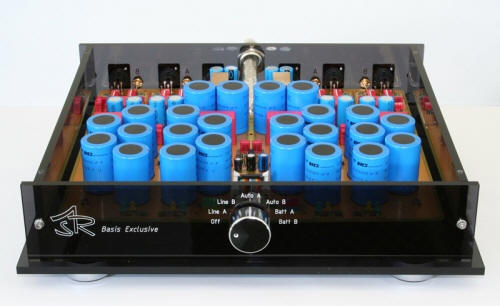|
|
You are reading the older HTML site
Positive Feedback
ISSUE
57
ypsilon VPS 100 Phono Stage - Analog is Spoken Here as reviewed by Marshall Nack
Musical Drama The best phono stages have the ability to put drama into vinyl playback. You've probably experienced it at some point. The room goes silent; everyone is so tuned in it seems like nobody's breathing. The playback is riveting. It doesn't happen often, but these are the moments audiophiles live for. What I want to investigate here is what makes this happen—what's the trigger and how can I get more of it? The moderating panel at this point can be expected to pipe up about signal to noise ratios, transient speed, low-level detail, purity of signal, and the rest of the jargon you read in the high-end journals. And most audiophiles would give it a satisfied nod and move on. Well, I won't be nodding. I've heard far too many high-res, speed demon components that meet the above description but don't have it. Which suggests the list is incomplete at best. The Journey Let me share my journey of discovery. My first exposure to what I'll call Level 1 insight was back in January 2007 when I met the ASR Basis Exclusive. I was doing a phono stage shootout and the ASR stood apart. It was so eccentric—so qualitatively different from the other stages under consideration—at first I didn't know what to make of it. I described it thus: "It features not just the lowest "noise floor" I've ever heard with vinyl; it also purges all distracting, non-musical sounds that have been riding along unnoticed with, and masquerading as part of, the signal—stray mechanical noises that I didn't even know were there."
ASR Basis Exclusive (2008 model) The ASR was one of those products that shook up my firmament. It remains your best buy at $9000 MSRP for the dual input version. I bought the review sample. The ASR has the S/N ratio, the high-res, and the purity admired by the moderating panel. However, good as it is, you're still missing out. The elusive drama remains absent. Further, it lets you know you're listening to a reproduction. Level 2 Level 2 insight came with designs employing step-up transformers, especially the Art Audio Vinyl Reference and the Audio Note Japan M-77 pre-amp.
ART Audio Vinyl Ref Now we heard new elements—timbral flow and dynamic continuousness—that are not part of the objectivist definition. Continuousness is the key word here—I'm convinced it's essential. While some of the cognoscenti are beginning to talk more about this in the audio press, step-ups remain unpopular, because they typically fall short on many of the objectivist criteria. Level 3 Level 3 insight is now. As I write this review, I'm listening to the Ypsilon VPS 100 phono stage, and the missing ingredient has made its appearance—the drama is there. The VPS puts it all together.
HD vs. TV It took the VPS to put the ASR in perspective. I was happy with the ASR 'cause it's definitely in the big leagues. But I got news for ya: There's a whole other strata of info out there, beyond the chair scrapes, the page turning and the players breathing. What is really stunning is the amount of important low-level stuff the VPS brings forth. Things like the modulation in sound caused by the friction of the bow grabbing the string. Like the micro details that support the impression of a human being making music. Beyond the quantity of this material is the incredible timbral fidelity that the ASR doesn't even hint at. (Note: my ASR is the 2008 model, not the current one.) How the VPS resolves timbre is like alchemy—now we're in the exalted realm of the ANJ M-77, where you never need ask what instrument is playing. Few components attain this level of fidelity. If I wanted to leave my panel slack-jawed, I would put on Tchaikovsky: Manfred Symphony, with Andre Previn and the London Symphony Orchestra, a splendid limited edition Alto reissue of EMI ASD 3018. Those silky strings—never heard that before. The beauty of those woodwinds! Those massive dynamic swings! And every instrument is properly sized and exactly where it should be on the stage. Too Much of a Good Thing? Especially now, because when the VPS 100 arrived I was finishing up a review of the Dr. Feickert Blackbird turntable and also in the midst of reviewing the Tenor 175S, a tube hybrid stereo amp. And everything was wired with K-S Elation!. This component lineup brought us the finest vinyl reproduction—it put vinyl into orbit.
Initially, I was concerned about introducing the five tubes of the VPS 100 on top of the eight in the Tenor. Might this compound the valve colorations, possibly pushing it into filament euphony? No, it didn't work out that way. Sure it got sweeter, but not to the point of becoming objectionable. If your definition of tubey includes fleshy images and a fatter, warm sound, the funny thing is the ASR has more of that. Here's another snippet from my phono shootout: "The ASR stage is not the jewel-like sharp and hard edges of a cool, polished diamond; rather, it's more like a purposefully worked hunk of bronze…" And its tonal balance is noticeably darker. The VPS has more focus and crisper transients. Its bass is warm, but with more definition than the ASR. Which is the one with the tubes? Go figure. Enough ink has already been spilled about the piano and the bass on Waltz for Debby (Analogue Productions APJ 009 reissue of Riverside 9399). What I want to focus on is Paul Motian's cymbal work, which I find strikingly improved in this iteration. On My Foolish Heart, he plays almost exclusively on the sizzle cymbal (the one with the rivets over on stage right). That metal disc occupies a large chunk of soundstage real estate. Its virtual volume has swollen drastically and he's taping out a little tune on it. In the past that cymbal work sounded like white noise. As with most of these audiophile reissues, the sound is noticeably pumped up and larger than life. The trio is not just in the room—they've taken over the room. But I'm enjoying the heck out of it. The Next Level: Transient and Tail Unlike any device I'm aware of, the VPS 100 gives full expression to what happens when the player stops blowing or sawing and the room contribution takes over. When the note ends, reverberation begins and lingers for some duration. Through the VPS this sounds different enough from the sustain that you can tell something new has begun. Breaking Silence Finally, and critically, the transient has to be perfect. The note arrives out of dead silence and that event cannot be compromised. You can't have a sloping or rounded leading edge. It must be coherent and it must be deliberate and decisive. When a note needs to move, it cannot be timid or tentative. When it is done right, the result is drama. The Ypsilon gets it perfectly. Design If you've gotten this far, no doubt you are wondering how the VPS 100 accomplishes such stellar performance? The design goals are two-pronged: it follows both the Japanese model and is respectful of the minimalist approach. What sets it apart from others on this road is Ypsilon's determination to take this approach to the limit.
The VPS 100 has no switches. The only thing in the signal path is a pair of C3g tubes in the input stage and another pair of C3g in the output stage. (The unit has one other tube, a 6CA4 valve for rectification.)
Passive RIAA Equalization The design team decided to use passive RIAA equalization, an uncommon approach. Quoting from the website: "In the past an alternative way of implementing a RIAA equalizer the LCR (Inductance-capacitance-resistance) circuit was proposed. A long time ago TANGO transformers from Japan used to produce such a circuit working in 600 Ohms. A few manufacturers are using LCR based phono stages using variations of the original TANGO LCR circuit. The challenge in 600 Ohm LCR eq is to drive the network properly; having no more than 2 gain stages with enough overall gain and low enough output impedance. The best way of driving the LCR network is by using a transformer. A properly implemented LCR RIAA sounds much more natural, musical and open than CR networks with better defined macro and micro dynamics." The VPS 100 output level is 39db, suitable for a MM cartridge. To use MCs, you'll need a step-up transformer for extra gain. Ypsilon transformers are external to the main unit. They look beautiful. They are hand wound in-house using copper windings around a special amorphous C-core material with insulation made of paper. Ypsilon makes three for the VPS 100. Why three? Because each has a fixed amount of gain and they are not adjustable. • MC10: provides 20db of gain suitable for cartridges with 0.4 - 0.6mv output. • MC16: provides 24db of gain for cartridges with 0.3 - 0.4mv • MC20: provides 26db of gain for cartridges with 0.2 - 0.3mv Each costs $2800. Most customers purchase two step-up models to give them more cartridge options.
The Consequences of Minimalism This is one of the consequences of taking minimalism to the extreme. The unit doesn't come with the usual battery of controls. There are no switches for loading, gain or impedance adjustment. Cartridge loading is fixed at these values: • MC10: 500 ohm • MC16: 200 ohm • MC20: 140 ohm Loading can be adjusted, but it requires an additional set of resistors, which plug into the loading jacks on the step-up. (These can be ordered from your dealer. I didn't need to use any with the Shelter Harmony.)
Construction The VPS 100 chassis is made in Germany. Apart from that, everything is made in-house, the old-fashioned way. Your phono cable, including the ground wire, connects to the step-up. A single-ended interconnect goes between the step-up and the VPS 100. You may need to run a ground wire between them as well. I did; I'm told other people don't. What will work best in your system can only be determined by trial. It has both RCA and XLR outputs. Daily Warm-Up Period The VPS 100 will sound better after an hour warm-up. But if you really want to hear what it's capable of, try leaving it on overnight. You will be shocked at the difference—perhaps on the order of 15%. It all comes into focus; noise and distractions go away. You are presented with an immaculate soundstage and an unprecedented level of transparency. Everything on it seems to belong; nothing is extraneous. Once I discovered this, the unit remained on for the duration of the review. I'm guessing this boost might have to do with the internal temperature stabilizing. Or perhaps the 7 or 8 transformers inside the main chassis need to come to a stable operating temperature? At any rate, if you opt to leave the VPS 100 on 24/7, the tubes will be good for about two years. The C3g Siemens and the 6CA4 tubes have a life expectancy of at least 10,000 hours. Premium replacement tube sets are available through your dealer.
The Step-up Signature Now is the time to talk about step-ups and their signature. Typically, designs employing step-ups suffer in the areas of dynamics, speed and frequency extension. True enough: If the VPS 100 isn't configured right it can sound this way. When I arranged this review, I gave the importer the specs for my Shelter Harmony cartridge. He sent me the MC10 and the classic symptoms were in evidence. When I reported this, he quickly sent over the MC16. With the replacement step-up, the stereotype signature totally disappeared. So, in answer to the question what makes the drama appear: it happens when you conjoin top grades on the scorecard with the strengths of the step-up, and somehow avoid the step-up liabilities. This is what had us drooling. Only guys with a reference point like the Soulution Phono Stage had quibbles with the VPS 100 performance. Because, while the VPS100 is Class A all the way, it is not at the level of the Soulution on the scorecard items. Nothing is. But, in turn, the Soulution doesn't have those extra musical qualities the step-up brings. Conclusion Most often, a review is a matter of chronicling how well a component does x, y, and z, how good it is at the familiar items on the audio report card. Very occasionally a component comes in that is able to nudge the listening experience in a novel direction. The Ypsilon VPS 100 Phono Stage is one of them. "Man, what a natural, refined sound!" was my first enthusiastic response to the VPS 100. The differences lay in the quantity and quality of low-level information. The convincing little events are there, but equally important as this abundance of micro-level stuff is their terrific timbral and dynamic fidelity. The VPS 100 conjoins excellent performance on the objectivist criteria with the unique qualities only step-up designs bring. The difference is this is the first step-up design that doesn't exhibit the step-up weaknesses. As a total package, the Ypsilon VPS 100 Phono Stage offers the finest, most satisfying, analog playback I've heard to date. Marshall Nack
VPS 100 Valve Phono Stage
Moving Coil Step Up Transformers (MC10 / MC16 / MC20)
Ypsilon Electronics Importer
Aaudio Imports
|







